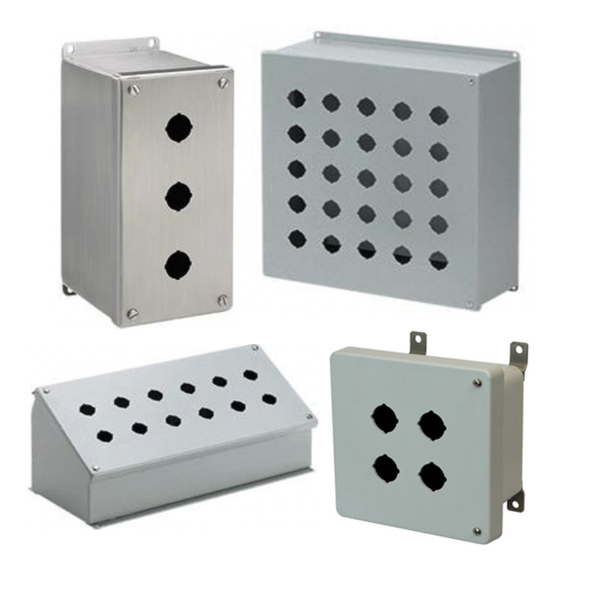Push Button Enclosures

RSP Supply carries a wide range of pushbutton enclosures designed to protect industrial control devices such as push buttons, pilot lights, indicators, and switches. These enclosures safeguard sensitive components from dust, moisture, and corrosion, ensuring long-term reliability and safe operation in industrial, commercial, and outdoor environments.
Available in 22.5 mm and 30.5 mm configurations with 1 to 42-hole options, our pushbutton enclosures are offered in stainless steel, steel, and non-metallic materials to suit different environmental and application needs. Each model is built for durability and is rated for NEMA 4X or IP65 protection, offering superior resistance to water, debris, and harsh elements.
Whether you’re building a custom control station or replacing existing housings, our pushbutton enclosures deliver the rugged performance and flexibility your systems demand. From single-hole boxes to large multi-control stations, RSP Supply ensures precise sizing, consistent quality, and fast availability.
Overview: Push Button Enclosures
Push button enclosures are protective housings designed to mount and safeguard push buttons, pilot lights, selector switches, and other control devices in industrial and commercial applications. They provide a durable, organized interface for machine operation while protecting internal wiring and components from dust, water, oil, and mechanical damage.
Available in a range of materials, including polycarbonate, fiberglass, carbon steel, and stainless steel, push button enclosures are suited for environments ranging from general industrial settings to harsh, corrosive, and sanitary washdown areas. Standard configurations support common 22 mm and 30 mm control devices, with blank or custom-drilled options available to meet specific application requirements.
With NEMA and IP ratings such as NEMA 4, 4X, and IP66/IP67, these enclosures deliver reliable protection for indoor and outdoor use. Their modular sizing, customization flexibility, and compliance with UL and international standards make push-button enclosures an essential component in automation, machinery control, and operator interface systems.
FAQs – Pushbutton Enclosures
1: Which brands of pushbutton enclosures does RSP Supply carry?
RSP Supply offers pushbutton enclosures from Allied Moulded, nVent Hoffman, and Rittal, providing a range of materials and configurations for industrial and commercial use.
2: What materials are available for pushbutton enclosures?
Our enclosures are available in stainless steel, carbon steel, and non-metallic fiberglass-reinforced materials, offering options for corrosion resistance, durability, and cost efficiency.
3: What NEMA or IP ratings do your pushbutton enclosures meet?
We carry NEMA 4X and IP65-rated pushbutton enclosures designed to protect against dust, water, and corrosion, making them suitable for indoor and outdoor environments.
4: What hole sizes and configurations are available?
RSP Supply offers 22.5 mm and 30.5 mm pushbutton enclosures with layouts from 1-hole to 42-hole options, perfect for single or multi-control applications.
Q: Where are push-button enclosures commonly used?
They are widely used in manufacturing, automation, food and beverage processing, pharmaceuticals, utilities, and material handling systems, anywhere reliable and protected operator controls are required.
Why Buy Pushbutton Enclosures from RSP Supply
When you choose RSP Supply for your pushbutton enclosures, you’re partnering with a trusted distributor dedicated to quality, performance, and reliability. We offer one of the most extensive selections of 1-hole to 42-hole enclosures designed for 22.5 mm and 30.5 mm pushbuttons, giving you the flexibility to meet any application requirement. Our enclosures are available in stainless steel, carbon steel, and non-metallic materials, ensuring long-lasting durability and resistance to corrosion in both indoor and outdoor environments.
With top brands such as Allied Moulded, nVent Hoffman, and Rittal, you can count on proven performance and engineering excellence. RSP Supply also offers fast delivery, expert technical support, and responsive customer service to help you find the right enclosure every time. Whether you’re designing a new control panel or upgrading existing equipment, RSP Supply delivers the right balance of quality, selection, and service to keep your operation running smoothly.

